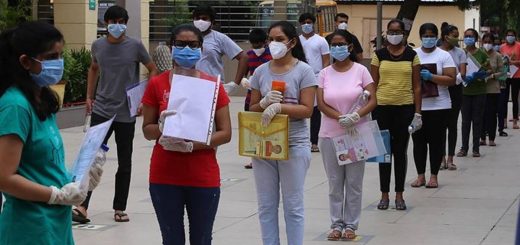‘My number one enemy’: The hidden financial aid hurdle derailing college students
SANTA CRUZ, Calif. — At 19, Elizabeth Clews knew attending community college while balancing a full-time job and caring for a newborn would be hard. But she wanted to give it a shot.
After a few months, the single mom, who had just exited the foster care system, realized she wasn’t doing well enough to pass her classes at Ventura College. “All I could really focus on was taking care of my baby and making sure that I kept a roof over our heads,” she said.
Clews thought her performance would improve if she quit work. But when she logged into the school’s online portal to register for a second semester, a message popped up that she described as saying, “You can enroll for classes, but you’re not gonna get financial aid.” Clews was in danger of failing to meet a standard called SAP, or “satisfactory academic progress,” which is attached to nearly all federal financial aid for higher education — including grants, loans and work study — and most state aid too.
“I didn’t really know it was a thing,” Clews said, “I didn’t understand any of the financial aid terminology.” But one thing she knew with utter clarity: She couldn’t pay tuition and fees out of pocket. So, she dropped out.

The number of students across the U.S. affected by satisfactory academic progress requirements each year likely runs in the hundreds of thousands, yet until recently the issue garnered almost no attention from news media, academics and policy makers. “It’s not a noisy problem” because it doesn’t impact people with social capital and power, said Christina Tangalakis, associate dean of financial aid at Glendale Community College in Southern California.
Now, a loose coalition of nonprofits, legislators and financial aid administrators are trying to reform what they describe as overly punitive, vague standards that keep many students capable of earning a degree from obtaining one. The state of Indiana was an early actor, creating a grant in 2016 for returning students who had “SAP-ed out” of federal funding. Last month, California enacted legislation to make all colleges align their requirements for “satisfactory academic progress” with the federal minimum standard.
At the federal level, 39 nonprofit organizations sent a letter in August asking the U.S. Department of Education to clarify the rules around the SAP minimum requirements. And in Congress, Sen. Cory Booker, a Democrat, is expected to re-introduce SAP-related legislation that would give students a second chance at aid.
Related: ‘Revolutionary housing’: How colleges aim to support formerly incarcerated students
The logic behind satisfactory academic progress rules is that giving aid to students who are unlikely to graduate is a bad investment, wasting students’ time and taxpayers’ dollars.
The policy was created in 1976, and at first, each college or university was left to set its own standards. Then, in a 1981 report to the Senate, the General Accounting Office said tougher ones were needed. Citing little evidence, the agency asserted that $1.28 million had been accessed inappropriately.
“It was Reaganomics and welfare reform and this idea of deserving and undeserving poor,” said Debbie Raucher, the director of education for John Burton Advocates for Youth, or JBAY, a California nonprofit. The stance was “if a student isn’t pulling their weight, they don’t deserve our help,” she said.
Under current federal rules, students must maintain a 2.0 GPA or higher, complete at least 67 percent of credits attempted and stay on track to finish a degree in no more than 150 percent of the time it usually takes (for example, six years for a four-year degree). During the Obama administration, SAP regulations were further tightened in an attempt to prevent low-performing for-profit institutions from lining their pockets with taxpayer dollars.
“SAP is my number one enemy, my arch nemesis.”
Elizabeth Clews, University of California, Santa Cruz student who was kicked off financial aid because of SAP requirements when attending community college
Once a student becomes ineligible for financial aid after failing to make SAP, that status stays with them forever.
Some students appeal, but that process can be complicated and riddled with inconsistencies. Campuses aren’t required to offer appeals. Those that do grounds to “the death of a relative, an injury or illness of the student, or other special circumstances,” according to federal regulations. What circumstances qualify as “special” varies tremendously. For example, some schools explicitly allow students to appeal if they are struggling to balance school and work demands, while others explicitly disallow appeals on the same grounds, according to a 2023 analysis by JBAY.
At 20, Clews didn’t know anything about an appeal, but two years later, she felt “this itch to try again,” and attempted to re-enroll at Ventura. When she got a similar notification, a more mature Clews “decided to do some investigating.” She had experienced homelessness and food insecurity, but didn’t see those circumstances on the appeals list. Her takeaway was: “Oh, well you didn’t die, you didn’t get your leg cut off, so there’s no reason that you shouldn’t have been successful.”
So Clews worked as a waitress and in retail for the next five years.
“It was Reaganomics and welfare reform and this idea of deserving and undeserving poor.”
Debbie Raucher, the director of education for John Burton Advocates for Youth
This turn of events was, in part, the luck of the draw. Some schools are more stringent than the federal rules require: For example, JBAY identified 10 colleges in California that mandate a course completion rate between 70 and 80 percent, not 67. Some institutions require a 2.0 GPA every term, while others consider SAP satisfied if a student’s cumulative GPA is above the threshold. In deciding whether students are progressing fast enough, some colleges include remedial coursework and classes taken in pursuit of an old major, while others don’t. Raucher, of JBAY, said Ventura’s currently posted policy isn’t significantly stricter than average, but wouldn’t have offered Clews “the full leniency allowed by federal regs.” (A Ventura representative said in an email that the school follows federal and state guidelines.)
Fearful of government audits, financial aid administrators tend to take a conservative view of the regulations, Raucher said.
Both JBAY’s analysis and a 2016 study place the number of students who don’t meet SAP requirements at more than 20 percent of Pell grant aid recipients, with that share higher for community college students.
“This is not a fringe issue that 1 percent of students are facing,” Raucher said.
Glendale Community College’s Tangalakis, who has served at four different colleges in her 22-year career, said the policy can undermine colleges’ equity efforts. Institutions must demand rigor, she said, and that’s why they have an “academic progress” requirement for all students that is distinct from SAP.
But since SAP standards are sometimes stricter than the schools’ individual policies, Tangalakis said, low-income students “have to meet a higher standard simply because they have financial need.” The appeals process also often results in staff laying “a lot of unnecessary judgment” on students, she said, and may retraumatize students, who can be asked to prove hardships such as domestic violence.
“Ultimately, it’s just a very powerful message that says you don’t belong here,” Tangalakis said.
Two analyses place the number of students who don’t meet SAP requirements at more than 20 percent of aid recipients, with that share higher for community college students
After taking on a senior role at Glendale, she made changes. Tangalakis instructed her team to assess SAP using the most liberal interpretation of the federal regulations and to handle appeals generously, allowing consideration of anything a student thinks relevant and accepting a statement completed online or via phone (rather than demanding documentation from third parties as some schools do).
The result has been striking: According to Tangalakis, the share of students who lost aid for failing to make SAP fell from 9.3 percent in 2017 to 6.4 percent in 2021. And she found that students who failed SAP in 2021 went on to complete degrees and certificates at a significantly higher rate than those who’d failed in 2017. These gains were even larger for students from traditionally disadvantaged backgrounds.
Other research confirms SAP’s disparate impact along racial lines: In 2021, for example, JBAY found that Black students, Native American students and foster youth who received a Pell Grant ran afoul of SAP provisions at more than twice the rate of white, Filipino and Asian students.
In theory, if students who “SAP-out” find another way to pay for college, they can requalify for aid if they improve academically. But for most students, that creates a Catch-22, Raucher said: They can’t re-enroll without financial aid, and they can’t get financial aid without re-enrolling. State aid that bypasses SAP status can springboard adults returning to college out of that Catch-22. But most don’t offer it.
“Ultimately, it’s just a very powerful message that says you don’t belong here.”
Christina Tangalakis, associate dean of financial aid at Glendale Community College in Southern California
In practice, this means that students who fall short of SAP standards are significantly more likely to drop out. In the 2016 study of one unnamed community college system, for example, the majority of those who failed SAP, approximately 60 percent, dropped out. For many students, “there is no plan B,” Tangalakis said, and SAP is “just a de facto end to their academic journey a lot of times.”
Even just receiving a SAP warning can produce that result: An analysis of data from Minnesota community colleges, for example, showed that only half of students who received a notice that they were in danger of failing to make SAP in the fall of 2013 tried to return that spring.
That, it turns out, is what happened to Clews. The message she initially received from Ventura was a warning, not notice that she was already ineligible. A financial aid deposit for what would have been her second semester showed up in her bank account, but by then she’d left the area to try to find reliable shelter and employment. Of course, when she didn’t show up for those classes, she officially failed SAP. (The money was taken out of her tax refund.)
Related: Is California saving higher education?
Years later, the pandemic hit and Clews found herself in an unusual position – with free time. Yes, she was home-schooling two kids, but with restaurants and stores closed, she couldn’t work. She said she filed an appeal letter but couldn’t receive aid while it was pending. Normally, that would have meant no school, but like millions of Americans that year, Clews received pandemic stimulus checks from the federal government.
After reenrolling with that money, her GPA shot up. Clews said, “I was doing really well, and I realized, ‘Oh, it wasn’t that I wasn’t smart enough, I just didn’t have the resources and the support that I needed to be successful.’ ”
That jibes with a small 2021 interview study that did not detect a difference in motivation between Pell-eligible students who were meeting SAP and those who weren’t. The study suggests that students who fail SAP requirements often do so because their life circumstances are different, not because they’re less “cut out” to succeed academically. Other research shows that students who SAP-out stop pursuing a degree more often than their peers with similarly low GPAs who aren’t subject to SAP.
“What SAP policies end up doing is targeting students who are coming in with the biggest existing barriers, and then doubling down,” said Raucher, whose organization helped develop the California SAP reform bill.
That legislation, which passed unanimously, requires that colleges use the least stringent definition of SAP allowed by the federal regulations for state financial aid, in effect dictating how all aid is administered. It also encourages colleges to better communicate the policy to students and mandates changes to the appeal system, including creating a review process for denied appeals, and prohibits institutions from disenrolling a student for nonpayment of tuition while an appeal is pending.

The federal legislation Booker, the Democratic senator, is expected to introduce would be similar to a bill he proposed in 2020, allowing a renewal of SAP eligibility when a student “stops out” for two years or more. The 2020 bill didn’t advance in Congress, but Booker may have a co-sponsor this time around, as talks with several Republican senators are in progress.
“The satisfactory academic progress standard is not without its flaws,” said Virginia Foxx, a Republican congresswoman from North Carolina who serves as chairwoman of the House Committee on Education and the Workforce. “Senator Booker’s bill isn’t perfect, but I am always willing to find common ground to improve policies and outcomes for students.”
In the meantime, organizations including JBAY and the national nonprofit Higher Learning Advocates have asked Education Secretary Miguel Cardona to encourage schools to make the appeals process more user-friendly, among other changes. Tanya Ang, managing director of Higher Learning Advocates, said reforming SAP has bipartisan support because eliminating “unnecessary hoops” for degree completion helps more people gain skills they can use in the workforce.
In theory, stringent SAP requirements tell students where they stand and force them to improve. But the 2016 study didn’t find that SAP policies had much of an incentivizing effect, on average.
The message Clews received was the opposite: Don’t try. Because if at first you don’t succeed, there’s no chance to try, try again.
In 2022, she completed her classwork at Ventura and transferred to the University of California, Santa Cruz. Clews plans to become a teacher. “I’m thankful to be where I’m at,” she said, “but I definitely feel like it shouldn’t have been so hard to get back to school.”
This story about satisfactory academic progress was produced by The Hechinger Report, a nonprofit, independent news organization focused on inequality and innovation in education. Sign up for the Hechinger newsletter.




